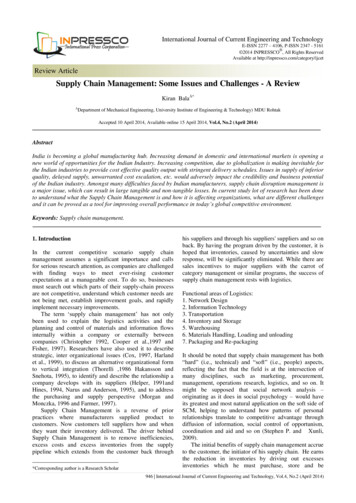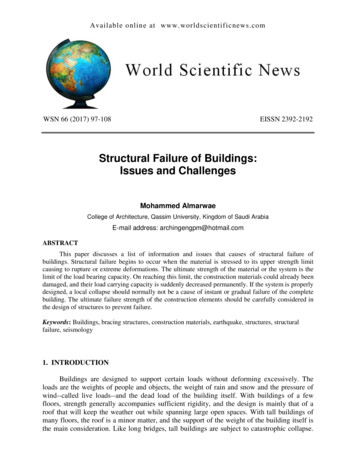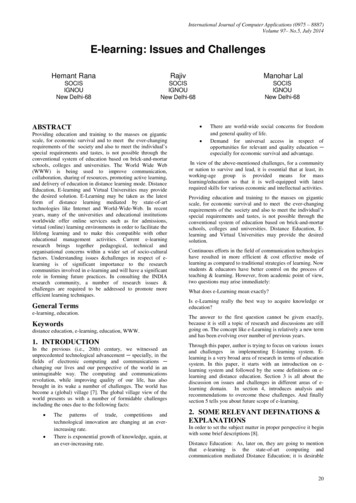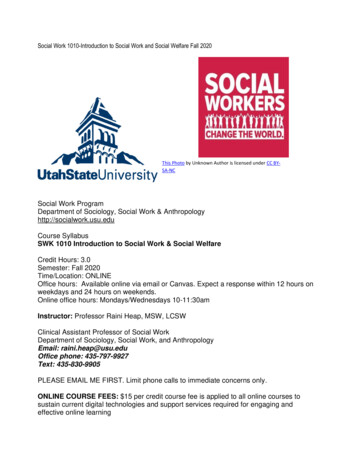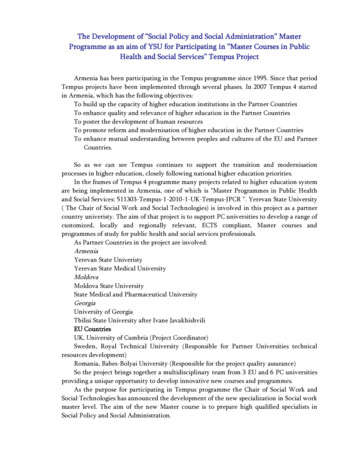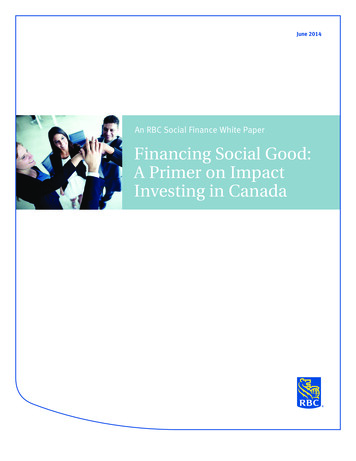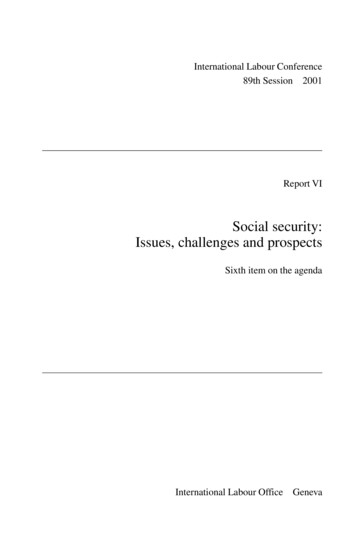
Transcription
IContentsInternational Labour Conference89th Session 2001Report VISocial security:Issues, challenges and prospectsSixth item on the agendaInternational Labour OfficeGeneva
IISocial security: Issues, challenges and prospectsISBN 92-2-111961-0ISSN 0074-6681First published 2001The designations employed in ILO publications, which are in conformity with United Nations practice, andthe presentation of material therein do not imply the expression of any opinion whatsoever on the part of theInternational Labour Office concerning the legal status of any country, area or territory or of its authorities,or concerning the delimitation of its frontiers.Reference to names of firms and commercial products and processes does not imply their endorsement bythe International Labour Office, and any failure to mention a particular firm, commercial product or processis not a sign of disapproval.ILO publications can be obtained through major booksellers or ILO local offices in many countries, ordirect from ILO Publications, International Labour Office, CH-1211 Geneva 22, Switzerland. A catalogueor list of new publications will be sent free of charge from the above address.Printed in SwitzerlandATA
ContentsIIICONTENTSPagesINTRODUCTION . . . . . . . . . . . . . . . . . . . . . . . . . . . . . . . . . . . . . . . . . . . . . . . . . . . . . . . . .1CHAPTER I. The prospects for social security . . . . . . . . . . . . . . . . . . . . . . . . . . . . . . . .3The global context . . . . . . . . . . . . . . . . . . . . . . . . . . . . . . . . . . . . . . . . . . . . . . . . .Social security and decent work . . . . . . . . . . . . . . . . . . . . . . . . . . . . . . . . . . . . . . .Some key issues . . . . . . . . . . . . . . . . . . . . . . . . . . . . . . . . . . . . . . . . . . . . . . . . . . .489Social security, employment and development . . . . . . . . . . . . . . . . . . . . . . .Extending the personal coverage of social protection . . . . . . . . . . . . . . . . . .Contributing to gender equality . . . . . . . . . . . . . . . . . . . . . . . . . . . . . . . . . . .Sustainable financing for social protection . . . . . . . . . . . . . . . . . . . . . . . . . .Expanding social dialogue . . . . . . . . . . . . . . . . . . . . . . . . . . . . . . . . . . . . . . .910101011The aim of the report . . . . . . . . . . . . . . . . . . . . . . . . . . . . . . . . . . . . . . . . . . . . . . .11CHAPTER II.Social security, employment and development . . . . . . . . . . . . . . . . . . . . .12The social and economic impact of social security . . . . . . . . . . . . . . . . . . . . . . . .12Social security expenditure, unemployment and growth . . . . . . . . . . . . . . . .Productivity and social stability . . . . . . . . . . . . . . . . . . . . . . . . . . . . . . . . . . .Employer contributions and international competitiveness . . . . . . . . . . . . . .Unemployment benefits, unemployment and employment . . . . . . . . . . . . . .Early retirement . . . . . . . . . . . . . . . . . . . . . . . . . . . . . . . . . . . . . . . . . . . . . . .1315161819Unemployment benefits and employment promotion . . . . . . . . . . . . . . . . . . . . . .19Relevant international labour standards . . . . . . . . . . . . . . . . . . . . . . . . . . . . .Industrialized countries . . . . . . . . . . . . . . . . . . . . . . . . . . . . . . . . . . . . . . . . .Middle-income developing countries . . . . . . . . . . . . . . . . . . . . . . . . . . . . . . .Other developing countries . . . . . . . . . . . . . . . . . . . . . . . . . . . . . . . . . . . . . .20202122Conclusions: Linking social security with employment and development policies23CHAPTER III. Extending the personal coverage of social protection . . . . . . . . . . . . . .25The right to social security . . . . . . . . . . . . . . . . . . . . . . . . . . . . . . . . . . . . . . . . . . .The problem of non-coverage . . . . . . . . . . . . . . . . . . . . . . . . . . . . . . . . . . . . . . . . .Policies to achieve the extension of coverage . . . . . . . . . . . . . . . . . . . . . . . . . . . .252627The economic, social and political context . . . . . . . . . . . . . . . . . . . . . . . . . .Strategies for extending social protection . . . . . . . . . . . . . . . . . . . . . . . . . . .2828Conclusions . . . . . . . . . . . . . . . . . . . . . . . . . . . . . . . . . . . . . . . . . . . . . . . . . . . . . .35
IVSocial security: Issues, challenges and prospectsCHAPTER IV. Gender equality . . . . . . . . . . . . . . . . . . . . . . . . . . . . . . . . . . . . . . . . . . .37International labour standards and gender equality . . . . . . . . . . . . . . . . . . . . . . . .The link between social protection and gender . . . . . . . . . . . . . . . . . . . . . . . . . . .The impact of labour market inequalities on different forms of social protection .Measures to grant equality of treatment in social protection and to promote genderequality through social protection . . . . . . . . . . . . . . . . . . . . . . . . . . . . . . . . .383939Survivors’ pensions . . . . . . . . . . . . . . . . . . . . . . . . . . . . . . . . . . . . . . . . . . . .Divorce and pension splitting . . . . . . . . . . . . . . . . . . . . . . . . . . . . . . . . . . . . .Pensionable age . . . . . . . . . . . . . . . . . . . . . . . . . . . . . . . . . . . . . . . . . . . . . . .Pension credits for persons with caring responsibilities . . . . . . . . . . . . . . . . .Sex-differentiated annuity rates . . . . . . . . . . . . . . . . . . . . . . . . . . . . . . . . . . .Parental leave and benefits and childcare services . . . . . . . . . . . . . . . . . . . . .Child benefit . . . . . . . . . . . . . . . . . . . . . . . . . . . . . . . . . . . . . . . . . . . . . . . . . .41424244444445Conclusions . . . . . . . . . . . . . . . . . . . . . . . . . . . . . . . . . . . . . . . . . . . . . . . . . . . . . .46CHAPTER V. The financing of social security . . . . . . . . . . . . . . . . . . . . . . . . . . . . . . . .47Global trends in social security expenditure . . . . . . . . . . . . . . . . . . . . . . . . . . . . . .Social security and its main challenges . . . . . . . . . . . . . . . . . . . . . . . . . . . . . . . . .4748Does social security face an ageing crisis? . . . . . . . . . . . . . . . . . . . . . . . . . .Or does social security face a globalization crisis? . . . . . . . . . . . . . . . . . . . .Has social security reached the limits of its affordability? . . . . . . . . . . . . . . .50505140National financing options . . . . . . . . . . . . . . . . . . . . . . . . . . . . . . . . . . . . . . . . . . .52Financing systems . . . . . . . . . . . . . . . . . . . . . . . . . . . . . . . . . . . . . . . . . . . . .The indispensable role of government as ultimate financial guarantor . . . . .5257Globalization and social security financing . . . . . . . . . . . . . . . . . . . . . . . . . . . . . .Conclusions . . . . . . . . . . . . . . . . . . . . . . . . . . . . . . . . . . . . . . . . . . . . . . . . . . . . . .5859CHAPTER VI. Strengthening and expanding social dialogue . . . . . . . . . . . . . . . . . . . .61Actors in social protection . . . . . . . . . . . . . . . . . . . . . . . . . . . . . . . . . . . . . . . . . . .61Family and local solidarity networks . . . . . . . . . . . . . . . . . . . . . . . . . . . . . . .Institutions of civil society . . . . . . . . . . . . . . . . . . . . . . . . . . . . . . . . . . . . . . .Enterprises and the commercial market . . . . . . . . . . . . . . . . . . . . . . . . . . . . .Government and social security institutions . . . . . . . . . . . . . . . . . . . . . . . . . .The international community . . . . . . . . . . . . . . . . . . . . . . . . . . . . . . . . . . . . .6162626363Partnerships for social protection . . . . . . . . . . . . . . . . . . . . . . . . . . . . . . . . . . . . . .64Enhancing the effectiveness of social security . . . . . . . . . . . . . . . . . . . . . . . .Towards social protection for all . . . . . . . . . . . . . . . . . . . . . . . . . . . . . . . . . .6466Conclusions . . . . . . . . . . . . . . . . . . . . . . . . . . . . . . . . . . . . . . . . . . . . . . . . . . . . . .69CHAPTER VII.Implications for future ILO work . . . . . . . . . . . . . . . . . . . . . . . . . . . . .70Research and policy development . . . . . . . . . . . . . . . . . . . . . . . . . . . . . . . . . . . . .70
ContentsVProviding a normative framework through standard setting . . . . . . . . . . . . . . . . . .Technical cooperation and other means of action . . . . . . . . . . . . . . . . . . . . . . . . .7274SUGGESTED POINTS FOR DISCUSSION . . . . . . . . . . . . . . . . . . . . . . . . . . . . . . . . . . . . . . . . .77STATISTICAL ANNEX . . . . . . . . . . . . . . . . . . . . . . . . . . . . . . . . . . . . . . . . . . . . . . . . . . . . .79
Introduction1INTRODUCTIONIn 1999 the Governing Body of the International Labour Office decided that ageneral discussion on social security should take place at the International LabourConference in 2001. The objective of this discussion is to establish an ILO vision ofsocial security that, while continuing to be rooted in the basic principles of the ILO,responds to the new issues and challenges facing social security. In a second stage thismay lead to the development of new instruments or to the possible updating or revisionof existing standards.1During the last two decades specific aspects of social security have been discussedat the International Labour Conference on various occasions. Most recently, in 2000,the Conference looked closely at the subject of maternity benefits when it revised theMaternity Protection Convention (Revised), 1952 (No. 103), and Recommendation(No. 95). Unemployment benefits were on the agenda in 1987 and 1988 when theEmployment Promotion and Protection against Unemployment Convention, 1988(No. 168), was discussed and adopted. In 1987 the Social Security (Seafarers) Convention (Revised) (No. 165) was adopted. The special needs of migrants were taken intoaccount with the adoption in 1982 of the Maintenance of Social Security Rights Convention (No. 157).However, it was in the 1950s — with the adoption in 1952 of the Social Security(Minimum Standards) Convention (No. 102) — and the 1960s — with the adoption ofa series of superior standards — that the Conference dealt with the broad range ofbenefits provided by social security.The last opportunity that the Conference had to consider social security as a wholewas at the 80th Session in 1993 in the discussion of the Report of the Director-General,Social insurance and social protection. That discussion confirmed the bleak pictureconcerning the developing countries painted in the Report. The unfavourable situationof women with regard to social protection was emphasized, as was the social distresswhich had resulted from structural adjustment policies. Some delegates had found theReport’s analysis too optimistic with respect to the industrialized countries, noting thatsocial protection was deteriorating, very often at the expense of the most vulnerablegroups of the population. The social problems in the economies in transition werestressed: to ensure a smooth economic transformation and the development of democracy, it was vital to strengthen social protection. Many spoke about the relationshipbetween economic growth and social protection, but it was clear that views differedconsiderably on this subject.The Governing Body has identified a number of key issues that should be takeninto account in the general discussion in 2001. These include: the interconnectionsbetween social security, employment and development; extension of the personal coverage of social protection; gender equality; the financing of social security; expanding1See ILO: Governing Body document GB.274/3, 274th Session, Geneva, March 1999.
2Social security: Issues, challenges and prospectssocial dialogue; and implications for future ILO work.2 In this report a chapter is devoted to each of these topics. The report begins by looking at the global context inwhich social security schemes are now operating and the relevance of social security tothe goal of decent work.2For a more detailed discussion of these and other issues concerning social security, see ILO: WorldLabour Report 2000: Income security and social protection in a changing world (Geneva, 2000).
The prospects for social security3CHAPTER ITHE PROSPECTS FOR SOCIAL SECURITYIn many parts of the world, in the closing years of the twentieth century, socialsecurity systems have been under challenge. Some consider that the systems are tooexpensive, and that they harm the process of economic growth and development.Others point to deficiencies in the level of protection and the scope of coverage, andargue that in times of increased unemployment and other forms of labour insecurity,social security is more needed than ever. Particularly in the industrialized countries(including the transition economies of Central and Eastern Europe), social securitysystems must respond to new demographic challenges, such as ageing and changingfamily structures, with important implications for the financing of social protection. Insome countries, there is dissatisfaction with the administration of social security, andcalls for reform involve a review of the role of the State, the responsibilities of thesocial partners and the desirability of greater participation of the private sector.One of the key global problems facing social security today is the fact that morethan half of the world’s population (workers and their dependants) is excluded fromany type of social security protection. They are covered neither by a contribution-basedsocial insurance scheme nor by tax-financed social benefits, while a significant additional proportion are covered for only a few contingencies. In sub-Saharan Africa andSouth Asia, statutory social security personal coverage is estimated at 5 to 10 per centof the working population and in some cases is decreasing. In Latin America, coveragelies roughly between 10 and 80 per cent, and is mainly stagnating. In South-East andEast Asia, coverage can vary between 10 and almost 100 per cent, and in many caseswas until recently increasing. In most industrialized countries, coverage is close to100 per cent, although in a number of these countries, especially those in transition,compliance rates have fallen in recent years.In most of its standard-setting and technical cooperation activities on social security, the ILO had expected that an increasing proportion of the labour force in developing countries would end up in formal sector employment or self-employment coveredby social security. It implicitly assumed that past economic and social developmentpatterns of the industrialized countries would replicate themselves in other regions.However, experience in developing countries — and more recently in the industrialized countries — has shown that this proportion is in many cases now stagnating ordeclining. Even in countries with high economic growth, increasing numbers of workers — often women — are in less secure employment, such as casual labour, homework and certain types of self-employment.The growth of informal, unprotected work creates dangers for formal and informaleconomy workers alike. The area of social protection illustrates the very real and directinterest, on the part of workers with “normal” employment status and of their organizations, in bringing informal economy workers into the mainstream of formal employment. With shrinking formal employment, workers bear an increasing direct burden of
4Social security: Issues, challenges and prospectsfinancing social needs, with adverse effects on their quality of life. That burden mayalso undermine the capacity of enterprises to compete in the global economy.THE GLOBAL CONTEXTGlobalization, either alone or in combination with technological change, often exposes societies to greater income insecurity. Research on the developed countries suggests that income transfers tend to be largest in economies that are simultaneously veryopen and subject to substantial price risk in world markets. Other observers claim thatreductions in income security and social protection arise from the attempts of governments to promote competitiveness and attract foreign direct investment. Some of themalso foresee that tax competition will lead to further reductions in taxes, particularly onreturns to capital, and lower the ability of governments to finance social protection.The structural adjustment policies pursued in most developing countries haveoften contributed to a decline in the small percentage of the working population in theformal sector. The successive waves of structural adjustment programmes have alsoled to wage cuts in the public and private sectors, thereby eroding the financial base ofstatutory social insurance schemes. Simultaneously, many such schemes in developingcountries have suffered from bad management and bad governance, which have oftenstrongly reduced the trust of their members. In addition, structural adjustment programmes have often resulted in severe cuts in social budgets. In Benin, for example,health expenditure’s share in the total government budget dropped from 8.8 to 3.3 percent between 1987 and 1992. As most governments can no longer guarantee access tofree health and education, there is — apart from national systems — greater demandfor international and local arrangements to finance and organize these social services.Particularly in low-income countries, structural adjustment and socio-economicchanges have also produced large vulnerable groups that cannot contribute to socialinsurance schemes. The most vulnerable groups outside the labour force are peoplewith disabilities and old people who cannot count on family support, and who have notbeen able to make provisions for their own pensions. Some countries, such as Chinaand India, have taken specific social assistance measures to meet the needs of thesegroups.The world today also faces a large number of complex crises, often with globalrepercussions. One of the most visible recent examples has been the Asian financialcrisis, which led to massive job losses in the formal sector of the economy, rapidlyrising unemployment, and an expansion of employment in the informal economy.Then there have been many armed conflicts in recent years, particularly in sub-SaharanAfrica (Angola, Congo, Liberia and Rwanda, for example) but also in Europe (Bosnia,Kosovo). Numerous countries around the world continue to be afflicted by health disasters, such as the HIV/AIDS pandemic, leaving many children orphans (see box).Natural disasters, such as recurrent droughts and floods (in Africa and Asia), earthquakes and hurricanes (for example in Turkey and Central America) have not only leftmany communities without homes and sources of income but have also wiped awayyears of their countries’ efforts at development. Lastly, some countries are facing thedifficult process of making economic as well as political transitions, whether from acentrally planned economy to a market-oriented system, or from a politically restrictive regime like apartheid to a multiracial and democratic society. The transition in
The prospects for social security5Central and Eastern European countries led to unprecedented unemployment, whichstill persists in some of these countries. In these countries and in the former USSR theresponsibility for income security and certain social services has often shifted fromenterprises in the context of centrally planned economies to other, often weak andinadequate, schemes, a situation which threatens to leave many workers with reducedbenefits or no protection whatsoever. In South Africa, the peaceful transition from anapartheid political regime to a democratic and inclusive one has not as yet yieldeddecent jobs, appropriate incomes and improved economic conditions for the majorityof the population.The challenge of HIV/AIDS for social securityThe HIV/AIDS pandemic is the most dramatic of the challenges facingsocial security in certain countries, notably in Africa. Its human consequences are becoming all too evident, but its implications for social security systems are still far from fully known or understood.The pandemic has served to underline the gravely inadequate natureof social protection systems in the countries most affected. Many of theindividuals who have been infected have no social security coverage. As aresult they typically do not have access to the quality medical care theyrequire. Nor — if they are breadwinners — do their dependants receiveProbability of a 15-year-old boy dying before age 50, Zimbabwe
6Social security: Issues, challenges and prospectsany replacement income when they die or become unable to carry onworking. The first figure shows how dramatic the situation already is inmany African countries. In a typical African country, Zimbabwe, a 15-yearold boy today has only about a 50 per cent chance of reaching age 50. Theequivalent figures for women are not available but it is to be expected thatthe pattern is not very different. That means implicitly that a huge numberof families will lose their prime-age breadwinners before the pandemiccan be halted.The informal social protection mechanisms (extended family, localcommunity) are being stretched well beyond breaking point by the largenumbers of adult breadwinners now being struck down in their prime.Never was it more clear why social solidarity and risk-pooling must beorganized on the widest possible basis: this is vital in order to ensure thatall the necessary help is channelled to the family, groups, communitiesand regions most direly affected.International solidarity is urgently needed to back up nationalefforts — particularly to help in prevention campaigns and to assist in theprovision of health care. Partnerships must be developed between thecompetent health authorities, governmental and non-governmental organizations and the drug industry to ensure a supply of medication which,if international prices were charged, would be totally beyond the reach ofpatients in certain communities. At the local level, social securityschemes, health care providers and social services must coordinate theirefforts in order that AIDS sufferers receive proper care in the most appropriate setting.Estimated change in per capita GDP caused by AIDS, Kenya (in 1985 Kenyanshillings)
The prospects for social securityThe finances of social security schemes are being affected in a numberof ways by the pandemic. Generally, their resource base declines with thegeneral contraction that the AIDS pandemic inflicts on national economies. The second figure shows the estimated effect of AIDS on the Kenyan gross domestic product (GDP).In the industrialized countries, the financial impact of HIV/AIDS ismuch less serious; in the United States, for example, spending on HIV/AIDS care represents less than 1 per cent of personal health care expenditure and the average cost of care per person is less than that of treatingmany other disabling conditions. However, the financial effects on individuals are often dramatic, particularly if they do not have adequate healthinsurance. In the United States, only 32 per cent of people with HIV haveprivate health insurance (compared with 71 per cent of Americans overall); almost 50 per cent depend on Medicaid or Medicare for coverage; andabout 20 per cent are uninsured. Even among people who have resources,the costs of HIV/AIDS care (approximately US 20,000 per annum per patient) can quickly exhaust their assets and leave them impoverished.1 Inmost other industrialized countries, social security health care systems ornational health services protect people from this risk.In many countries social security schemes will cease or have alreadyceased to receive contributions from workers who are unable to carry onworking. Depending on the scope of the scheme, they are having to finance considerably higher expenditure on medical care, cash sickness benefits, disability benefits and, ultimately, survivors’ benefits. Prematuremortality, on the other hand, will tend to reduce expenditure on old-agepensions, but these savings will become significant only at a much laterstage. Research is necessary to obtain the data that are indispensable formaking valid projections and thereby to ensure the financial equilibriumof social security schemes in the long term. As part of its action againstHIV/AIDS, the ILO is embarking on a project which seeks to assess theimpact of AIDS on the financial viability of social insurance schemes andnational budgets.2Employers’ and workers’ organizations have an enormously important role to play in dealing with the pandemic. The workplace is a setting inwhich highly effective preventive activities can be conducted. Investmentin such activities pays off handsomely by helping to retain a healthy andexperienced workforce and to contain the costs of employer medical care,sick pay and pension schemes. Companies can maximize the benefits oftheir prevention activities by involving not only their employees, but alsotheir clients and the community of which they are a part.1Kaiser Family Foundation: “Financing HIV/AIDS care: A quilt with many holes”, in Capitol Hill Briefing Series on HIV/AIDS, Oct. 2000 (http://www.kff.org/content/2000/1607/).2ILO: ILO action against HIV/AIDS: A draft framework for global and regional initiatives,discussion paper on HIV/AIDS and the world of work (Geneva, 1999). See also ILO: HIV/AIDS inAfrica: The impact on the world of work, study prepared for the Africa Development Forum2000, Addis Ababa, 3-7 Dec. 2000, and HIV/AIDS: A threat to decent work, productivity anddevelopment, document for discussion at the Special High-Level Meeting on HIV/AIDS and theWorld of Work, Geneva, 8 June 2000. These reports, as well as further information on the ILOGlobal Programme on HIV/AIDS and the World of Work, are available on the ILO website, athttp://www.ilo.org/aids.7
8Social security: Issues, challenges and prospectsSOCIAL SECURITY AND DECENT WORKPeople wish to secure a decent standard of living, within a context of security andof freedom to express their opinion and to associate. They can achieve this incomesecurity not only through productive employment, savings and accumulated assets(such as land and housing), but also through social protection mechanisms. Thesemechanisms function not only as a protective but also as a productive factor. Workersneed income security to make long-term plans for themselves and their families.Workers’ income security is also good for the economy, since it makes effective demand more predictable and provides enterprises with a more productive and flexibleworkforce.The objective of most social security schemes is to provide access to health careand income security, i.e. minimum income for those in need and a reasonable replacement income for those who have contributed in proportion to their level of income. TheIncome Security Recommendation, 1944 (No. 67), for instance, focuses on compulsory national social insurance schemes, which in principle also cover the self-employed, and provides for social assistance. In practice, however, it has been verydifficult to implement this concept in the case of workers, such as many of the selfemployed, who have irregular patterns of income, for whom the concept of earningsitself is difficult to measure and who generally have different social security needs andpriorities. The emergence of new contributory schemes for workers in the informaleconomy has highlighted this need for a wider concept. A broader social security concept could cover, for example, some housing, food security and child education benefits, in addition to the contingencies foreseen in the Social Security (MinimumStandards) Convention, 1952 (No. 102) (medical care and family benefits, as well asbenefits in the event of sickness, unemployment, old age, employment injury, maternity, invalidity and death of the breadwinner).Various authors and institutions, in particular those with experience in developingcountries, have pleaded for a broader definition of social security. Some claim that —within the context of a developmental anti-poverty strategy — social security couldalso include policies, for example on access to productive assets, employment guarantee, minimum wages and food security. Others distinguish two aspects of social security, which are defined as the use of social means to prevent deprivation (promoteliving standards) and vulnerability to deprivation (protect against falling living standards). Many international organizations, including the ILO, also use the broader concept of “social protection”, which covers not only social security but also non-statutoryschemes; the Statistical Office of the European Communities (Eurostat) includes in itsfigures for social protection certain social services such as crèches and home help.The goal and concept of decent work match this broader concept of social security.In his first Report to the International Labour Conference, the Director-General of theInternational Labour Office, Mr. Juan Somavia, introduced the “decent work for all”strategy, which established as the primary goal of the ILO “to promote opportunitiesfor women and men to obtain decent and productive work, in conditions of freedom,equity, security and human dignity”.1 The decent work strategy adopts a broad per-1ILO: Decent work, Report of the Director-General, International Labour Conference, 87th Session,Geneva, 1999, p. 3.
The prospects for social security9spective on work, which includes not only (paid) employment, but also work at homeso as to take gender roles into consideration. Decent social protection can thereforeplay an important role in achieving gender equality (see Chapter IV), if all peo
2 Social security: Issues, challenges and prospects social dialogue; and implications for future ILO work.2 In this report a chapter is de-voted to each of these topics. The report begins by looking at the global context in which social security schemes are now operating and the relevance of social
